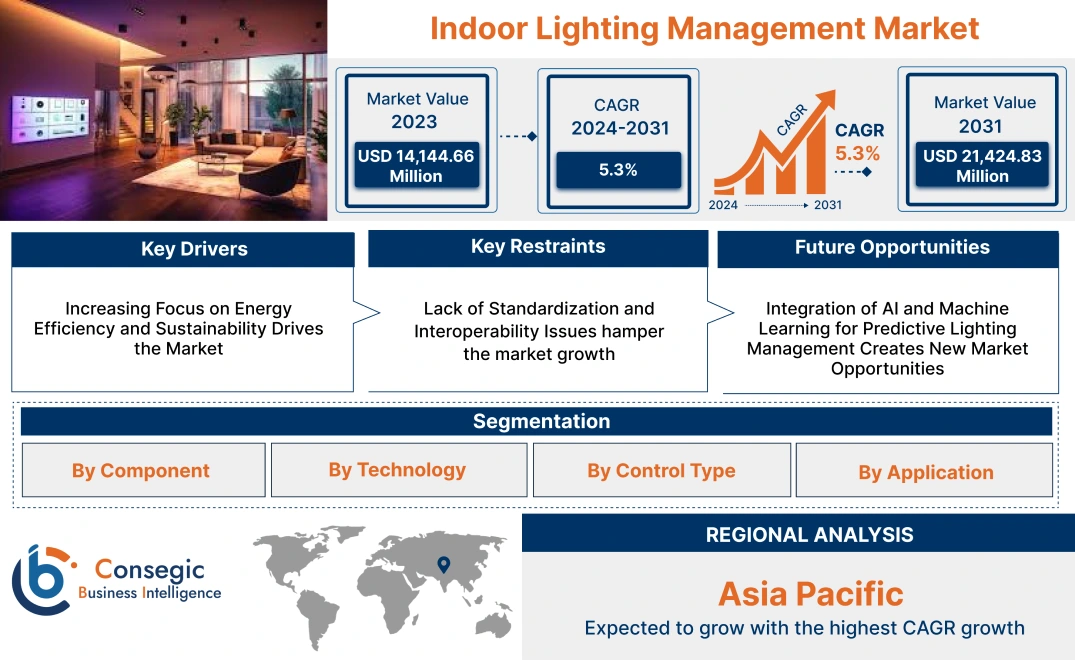- Summary
- Table Of Content
- Methodology
Indoor Lighting Management Market Size:
Indoor Lighting Management Market size is estimated to reach over USD 21,424.83 Million by 2031 from a value of USD 14,144.66 Million in 2023 and is projected to grow by USD 14,646.23 Million in 2024, growing at a CAGR of 5.3% from 2024 to 2031.
Indoor Lighting Management Market Scope & Overview:
Indoor lighting management refers to systems and technologies designed to control and optimize the use of lighting within indoor environments. These systems integrate sensors, automation, and smart controls to adjust lighting levels based on factors such as occupancy, daylight availability, and user preferences. Indoor lighting management solutions enhance energy efficiency, improve user comfort, and reduce operational costs by ensuring optimal lighting conditions in residential, commercial, and industrial spaces.
These systems include components such as LED lights, dimmers, motion sensors, and smart lighting controls, allowing for seamless automation and remote management. End-users of indoor lighting management systems include commercial buildings, industrial facilities, residential complexes, and public infrastructure. As the need for energy-efficient solutions grows, these systems are becoming integral to modern building designs, offering enhanced control, cost savings, and adaptability to varying lighting needs.
Indoor Lighting Management Market Dynamics - (DRO) :
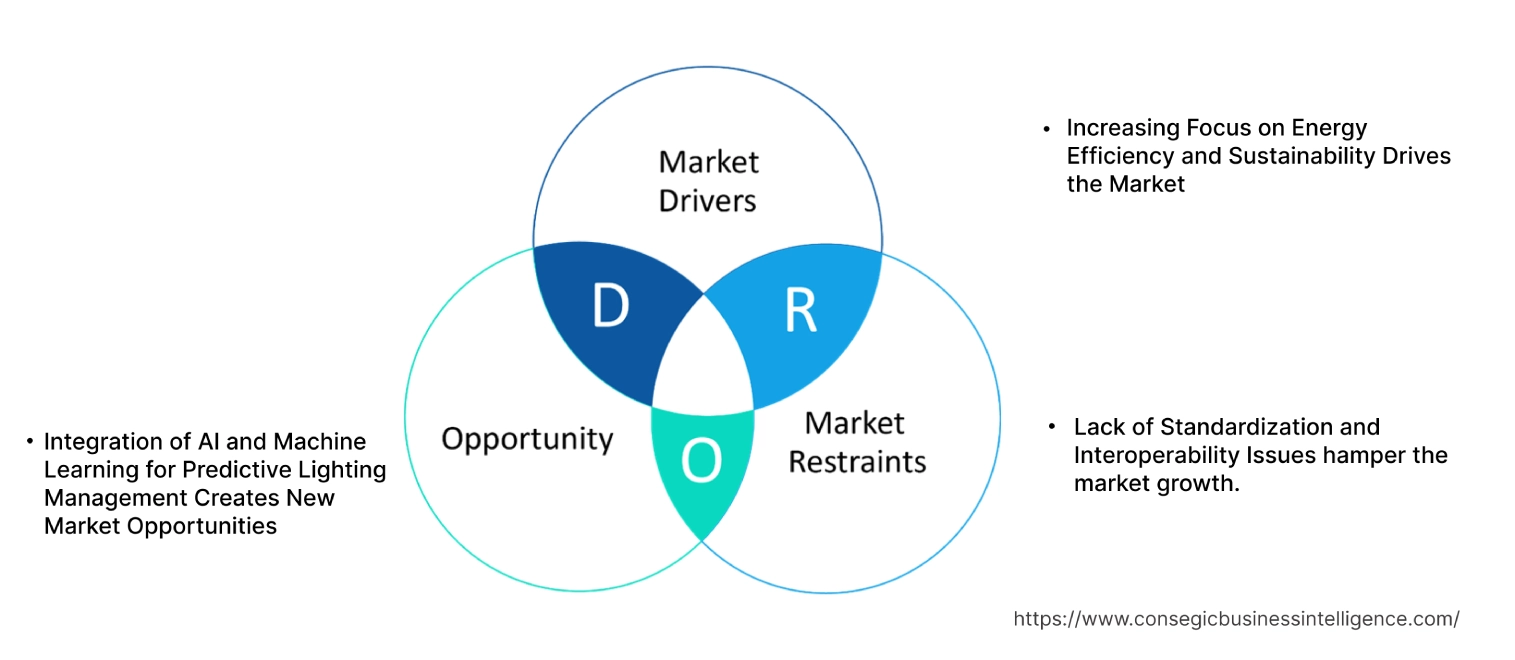
Key Drivers:
Increasing Focus on Energy Efficiency and Sustainability Drives the Market
One of the primary drivers of the indoor lighting management market is the growing focus on energy efficiency and sustainability. Commercial, residential, and industrial sectors are increasingly adopting smart lighting solutions that reduce energy consumption and minimize environmental impact. As governments around the world implement stricter energy efficiency regulations, businesses are seeking solutions to meet these standards and lower operational costs. Technologies such as LED lighting, combined with intelligent lighting control systems, allow for more efficient energy use through features like automatic dimming, occupancy sensors, and daylight harvesting, which adjust lighting levels based on the presence of individuals or the amount of natural light available. The push toward green building certifications like LEED (Leadership in Energy and Environmental Design) has further fueled the indoor lighting management market growth, as companies prioritize sustainability and cost reduction in their building designs.
Key Restraints :
Lack of Standardization and Interoperability Issues hamper the market growth.
The lack of standardization in the indoor lighting management market, particularly in terms of interoperability between different devices and platforms, poses a major constraint. As more companies develop smart lighting solutions, the industry has seen an influx of proprietary systems that may not be compatible with other IoT-enabled building management systems. This creates difficulties for businesses looking to integrate lighting solutions into existing infrastructure or across different manufacturers. The absence of universal standards for smart lighting protocols and communication systems has resulted in fragmented solutions that can be difficult to manage, reducing the overall efficiency of the system. This lack of interoperability slows down the deployment of smart lighting solutions and increases the risk of vendor lock-in, where companies are forced to rely on a single vendor for all future upgrades and maintenance, limiting flexibility and increasing long-term costs. Hence, the above-mentioned factors are key significant constraints that hinder the indoor lighting management market expansion.
Future Opportunities :
Integration of AI and Machine Learning for Predictive Lighting Management Creates New Market Opportunities
The integration of artificial intelligence (AI) and machine learning (ML) into indoor lighting management systems presents a significant growth opportunity. By using AI algorithms to analyze data collected from sensors, occupancy patterns, and environmental conditions, lighting systems can be optimized in real time to provide enhanced energy savings and occupant comfort. For example, AI-powered lighting systems can predict occupancy trends based on historical data, adjusting lighting in advance to maximize efficiency and improve the user experience. Additionally, predictive maintenance can be enabled through AI, allowing facility managers to detect potential issues in lighting systems—such as fixture malfunctions or energy inefficiencies—before they result in costly repairs or downtime. The ability to automate decision-making in lighting management through AI and ML opens new avenues for companies to reduce operational costs while providing highly adaptive and responsive lighting environments. Therefore, this growing emphasis on AI and Machine Learning drives the indoor lighting management market opportunities.
Indoor Lighting Management Market Segmental Analysis :
By Component:
Based on components, the indoor lighting management market is segmented into hardware, software, and services.
The hardware segment accounted for the largest revenue share of 65.38% in 2023.
- The hardware segment includes essential components such as sensors, controllers, and lighting fixtures, which are fundamental to indoor lighting systems.
- Sensors play a key role in detecting occupancy, ambient light, and motion, enabling efficient control of lighting based on environmental conditions.
- Controllers manage the lighting operations based on input from sensors, while lighting fixtures serve as the primary source of illumination.
- The increasing adoption of energy-efficient LED lighting, combined with advanced sensors and controllers for optimized energy usage, drives the demand for hardware components in indoor lighting management systems.
- The hardware segment leads the market due to its essential role in providing the core components for indoor lighting systems, further boosting the indoor lighting management market demand.
The services segment is anticipated to register the fastest CAGR during the forecast period.
- The services segment encompasses installation, maintenance, and consulting services, which are critical for the effective implementation and operation of indoor lighting management systems.
- With the increasing complexity of lighting solutions, particularly in commercial and industrial applications, the need for professional installation and ongoing maintenance services is growing.
- Additionally, consulting services are gaining traction as organizations seek expert guidance to optimize their lighting solutions for maximum efficiency and cost savings.
- The shift towards integrated lighting solutions that require regular updates and support is driving the rapid development of the services segment.
- The services segment is expected to grow rapidly, driven by the increasing requirement for professional installation, maintenance, and consulting services that ensure the efficient operation of advanced lighting systems.
- As per segmental trends analysis, the services segment boosts the indoor lighting management market expansion.
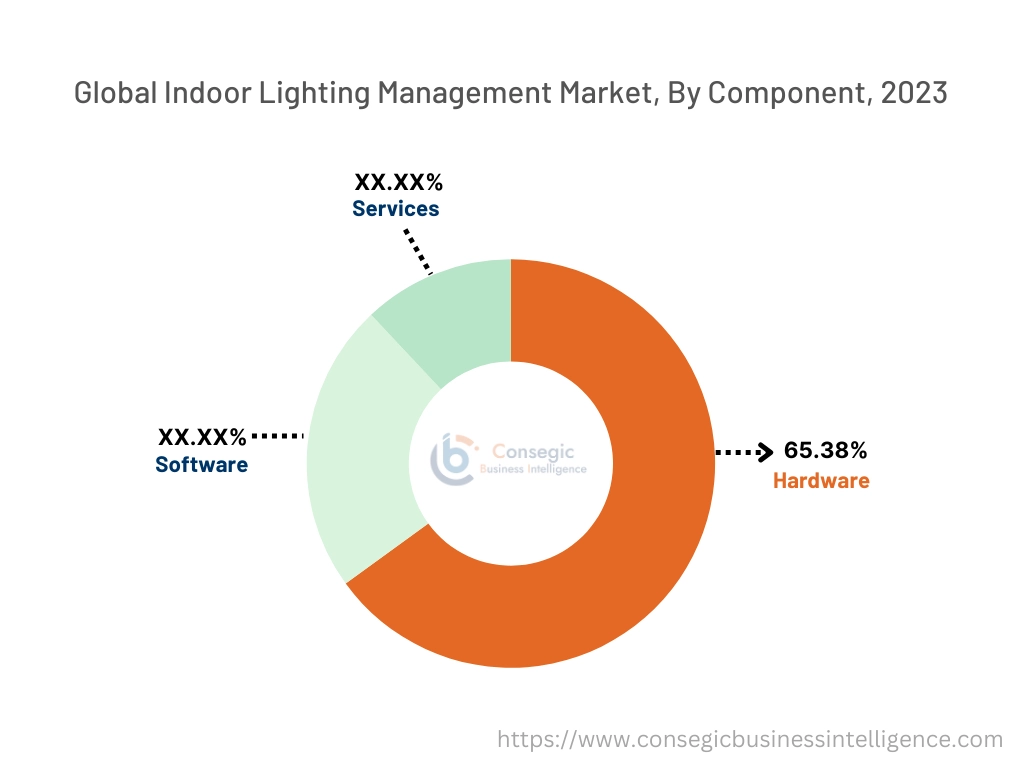
By Technology:
Based on technology, the market is segmented into wired lighting control systems, wireless lighting control systems, and IoT-based lighting control systems.
The wired lighting control systems segment accounted for the largest revenue share of the total indoor lighting management market share in 2023.
- Wired lighting control systems are known for their reliability and stability, making them a preferred choice in large commercial and industrial buildings.
- These systems use physical cabling to connect various components, minimizing interference and ensuring consistent performance.
- Wired systems are particularly favored in settings where consistent and uninterrupted lighting control is crucial, such as healthcare facilities and data centers.
- The established infrastructure of wired systems, combined with their proven reliability, contributes to their dominant position in the market.
- Wired lighting control systems dominate the market due to their reliability and stability, particularly in large-scale commercial and industrial applications where consistent performance is essential.
- Therefore, due to the aforementioned benefits of wired lighting control systems it drives the market progress.
The IoT-based lighting control systems segment is anticipated to register the fastest CAGR during the forecast period.
- IoT-based lighting control systems leverage internet connectivity to offer advanced, automated control of lighting based on real-time data and user preferences.
- These systems provide significant energy savings and enhanced user experience by enabling remote access and integration with other smart building systems.
- The growing adoption of smart home technologies and the increasing focus on sustainable building management are driving the need for IoT-based lighting control systems.
- The flexibility and scalability of these systems make them an attractive option for both new installations and retrofits.
- IoT-based lighting control systems are expected to grow rapidly, driven by the rising demand for smart, connected solutions that offer enhanced energy efficiency and user control.
- Therefore, as per segmental trend analysis, the IoT-based lighting control systems segment drives the market development.
By Control Type:
Based on control type, the market is segmented into dimming control, occupancy-based control, daylight control, color control, and others.
The dimming control segment accounted for the largest revenue share in 2023.
- Dimming control allows users to adjust the brightness of lights based on specific needs, leading to significant energy savings and enhanced comfort.
- This type of control is widely used in commercial and residential buildings to create adaptable lighting environments and reduce energy consumption.
- Dimming systems are particularly effective when combined with LED lighting, as they extend the lifespan of the lights and offer precise control over illumination levels.
- The increasing emphasis on energy efficiency and the growing popularity of adaptive lighting solutions are driving the adoption of dimming control systems.
- Dimming control leads the market due to its ability to enhance energy efficiency and provide adaptable lighting environments, making it a preferred choice in both commercial and residential applications.
- Thus, as per segmental trend analysis, the dimming control segment boosts the market development.
The occupancy-based control segment is anticipated to register the fastest CAGR during the forecast period.
- Occupancy-based control systems use sensors to detect the presence of individuals and automatically adjust lighting based on occupancy.
- These systems are particularly effective in reducing energy waste in spaces that are not continuously occupied, such as meeting rooms, restrooms, and storage areas.
- The growing focus on energy conservation and the increasing adoption of smart building technologies are driving the need for occupancy-based lighting controls.
- As organizations seek to optimize energy usage and reduce operational costs, the adoption of these automated systems is expected to increase rapidly.
- Occupancy-based control systems are expected to grow rapidly due to their effectiveness in reducing energy waste and their alignment with the trend toward smart, energy-efficient building solutions.
- Therefore, as per indoor lighting management market analysis, the occupancy-based control segment fuels the indoor lighting management market trends.
By Application:
Based on application, the indoor lighting management market is segmented into commercial, residential, industrial, and others.
The commercial segment accounted for the largest revenue share in 2023.
- Commercial buildings, including offices, retail spaces, and hospitality venues, are the primary adopters of advanced indoor lighting management systems.
- These environments require efficient, adaptable lighting solutions to enhance the comfort and productivity of occupants while minimizing energy costs.
- The widespread adoption of energy-efficient lighting systems, such as LED fixtures combined with smart controls, is driving improvement in the commercial segment.
- Additionally, regulatory requirements for energy conservation in commercial buildings are further propelling the demand for advanced lighting management solutions.
- The commercial segment leads the market, driven by the high requirement for efficient, adaptable lighting solutions that enhance occupant comfort and meet energy conservation regulations.
- Therefore, as per segmental trend analysis, the commercial segment boosts the market progress.
The residential segment is anticipated to register the fastest CAGR during the forecast period.
- The residential market is experiencing rapid progress as consumers increasingly adopt smart home technologies, including advanced lighting management systems.
- These systems offer homeowners enhanced control over lighting, allowing for customization and automation based on individual preferences and daily routines.
- The rising popularity of smart lighting solutions, coupled with growing consumer awareness of energy conservation, is driving the adoption of advanced indoor lighting management in residential settings.
- The integration of lighting controls with smart home platforms is further supporting this upswing.
- The residential segment is expected to grow rapidly, driven by the increasing adoption of smart home technologies and the rising consumer focus on energy-efficient lighting solutions.
- Therefore, as per the segmental trends analysis, the residential segment boosts the market development.
Regional Analysis:
The regions covered are North America, Europe, Asia Pacific, the Middle East and Africa, and Latin America.
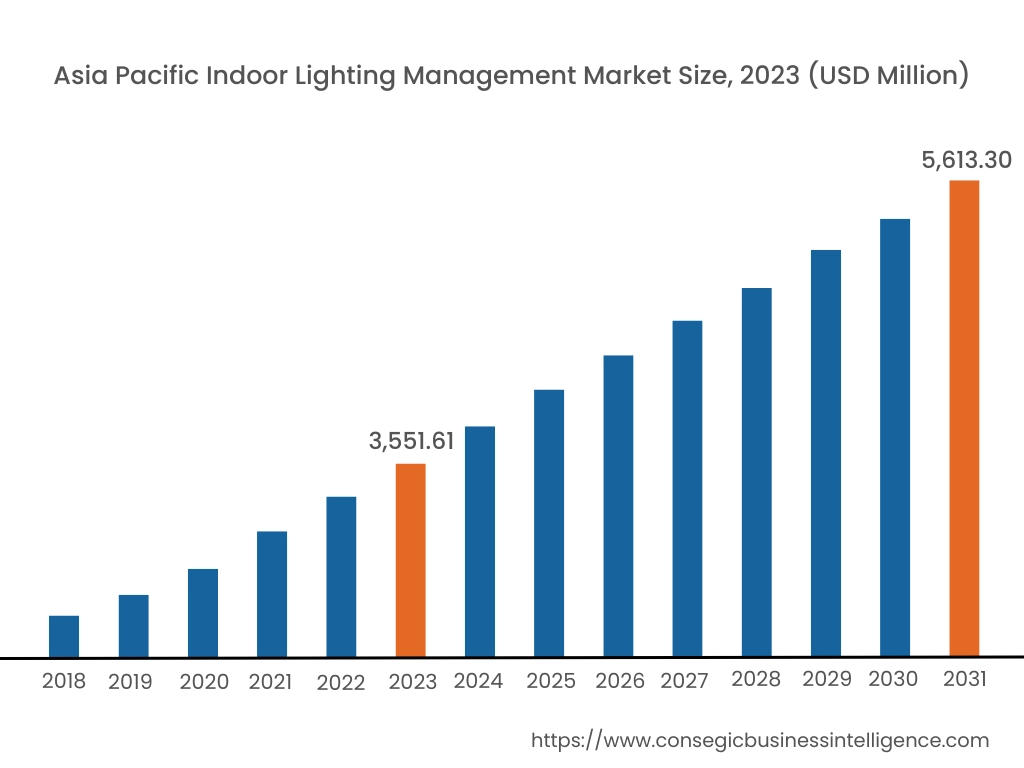
Asia Pacific region was valued at USD 3,551.61 million in 2023. Moreover, it is projected to grow by USD 3,690.86 Million in 2024 and reach over USD 5,613.30 Million by 2031. Out of these, China accounted for the largest share of 32.4% in 2023. The region is witnessing remarkable progress in the indoor lighting management market, driven by rapid urbanization, technological advancements, and the rising adoption of smart cities. China is at the forefront of this growth, where the government's focus on smart city development, green building initiatives, and large-scale energy-saving programs is transforming the market landscape. China's rapid growth in infrastructure and commercial developments pushes the necessity for intelligent lighting solutions, particularly in urban centers and newly constructed buildings. Similarly, India is rapidly adopting LED lighting and smart systems in response to increasing urbanization and the need to reduce energy consumption in its booming cities. Japan and South Korea, both leaders in technological innovation, are integrating advanced lighting management systems into smart homes, offices, and industrial settings.
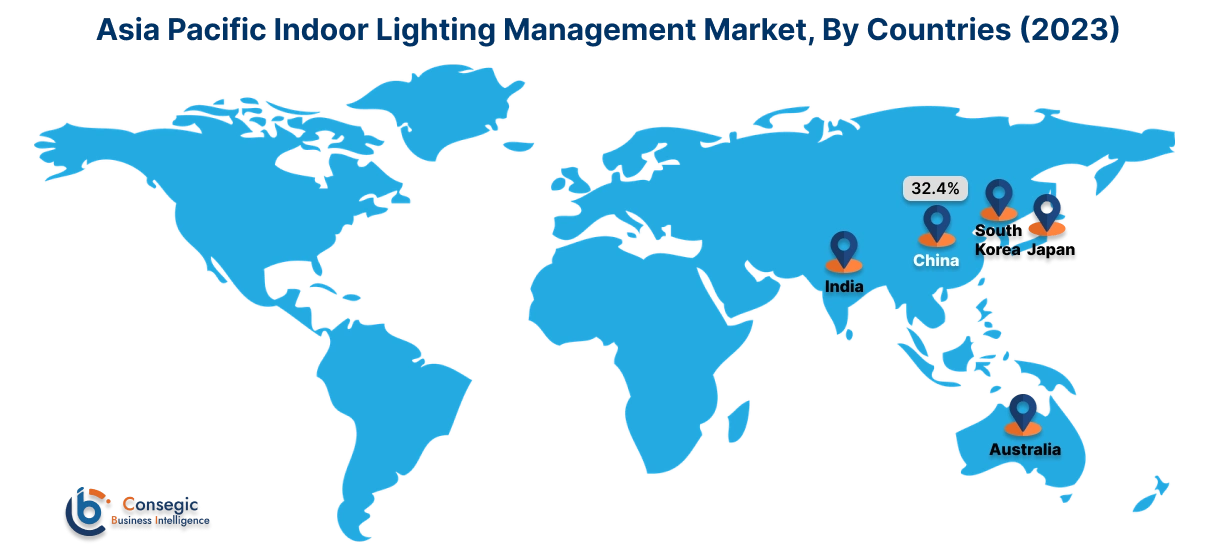
North America is estimated to reach over USD 8,312.83 Million by 2031 from a value of USD 5,541.29 Million in 2023 and is projected to grow by USD 5,733.20 Million in 2024. North America is a major player in the indoor lighting management market, primarily driven by the growing focus on energy-efficient lighting and the widespread integration of smart home technologies. The United States is a key contributor, where the demand for automated lighting systems and LED lighting solutions is increasing across residential, commercial, and industrial sectors. The market is further propelled by various energy-saving regulations such as Energy Star standards and building code mandates that encourage the use of high-efficiency lighting systems. Moreover, the rise of smart buildings, powered by IoT-enabled devices and automation technologies, continues to shape the adoption of intelligent lighting management systems. Canada also mirrors this trend with a strong commitment to sustainability and energy conservation, driving the market's expansion.
Europe is a critical market for the development of intelligent lighting management solutions, led by countries such as Germany, the UK, France, and the Netherlands. This region emphasizes energy efficiency and environmental responsibility, which propels the adoption of smart lighting systems across various building types. In Germany, for instance, the need for automated lighting in both residential and commercial spaces is significant, driven by the country's high standards for energy conservation and sustainability. The UK has also adopted smart technologies across office buildings, retail spaces, and public infrastructure as part of a nationwide push for green building standards. The EU's regulations, such as the EU Green Deal, which mandates strict compliance with sustainability goals, also influence the market, pushing organizations to adopt more efficient lighting management systems.
The Middle East and Africa region is progressively embracing indoor lighting management solutions, particularly in countries like the UAE, Saudi Arabia, and South Africa. The UAE leads the charge, with its ambitious smart city projects, including Dubai's initiatives, integrating energy-efficient lighting systems into the urban fabric. The country's focus on sustainability and smart technologies has driven a significant market pull for automated lighting systems in both residential and commercial buildings. In Saudi Arabia, Vision 2030 aims to reduce energy consumption across sectors, including lighting, further boosting the demand for smart lighting solutions. South Africa is also showing growth, particularly in urban areas where increasing population density and a need for energy-efficient solutions in commercial buildings are pushing strong requirements for intelligent lighting systems.
Latin America represents an emerging but growing market for indoor lighting management solutions, particularly in countries like Brazil, Mexico, and Argentina. Brazil is a major player, with a growing emphasis on energy-efficient lighting solutions as part of the country's commitment to sustainability. The demand for automated lighting is increasing across residential, commercial, and industrial applications as the country continues to implement green building standards. Mexico, with its expanding industrial base and urban growth, is seeing a rise in the adoption of smart lighting systems, particularly in commercial and public sector buildings. Similarly, Argentina is focusing on energy conservation and has adopted smart lighting in newer infrastructure projects.
Top Key Players & Market Share Insights:
The indoor lighting management market is highly competitive with major players providing indoor lighting services to the national and international markets. Key players are adopting several strategies in research and development (R&D), product innovation, and end-user launches to hold a strong position in the global indoor lighting management market. Key players in the indoor lighting management industry include –
- General Electric (USA)
- Crompton Greaves (India)
- Osram Licht AG (Germany)
- Havells Sylvania (India)
- Osram Sylvania (USA)
- Shenzhen MR LED (China)
- Koninklijke Philips N.V. (Netherlands)
- Thorn Lighting (UK)
- Ushio Lighting Technologies (Japan)
- Zumtobel Group (Austria)
Recent Industry Developments :
Partnerships & Collaborations:
- In March 2024, Samsung and Philips Hue expanded their partnership to enhance TV-centered home experiences. The collaboration integrates the Philips Hue Sync TV app with Samsung's SmartThings, allowing users to control smart lighting based on what's displayed on their TV. This app syncs lights for immersive viewing, gaming, and music, creating a more connected home entertainment experience. The integration also includes new countries and offers flexible subscription models for the Philips Hue Sync TV app.
Product Launches:
- In June 2024, Signify launched NatureConnect lighting at the India Light Festival 2024, designed to bring the benefits of natural light indoors. Inspired by biophilic principles, it mimics natural sunlight patterns, promoting well-being by regulating circadian rhythms, and improving mood, focus, and sleep quality. The system includes SkyRibbon, Daylight, and Skylight, providing flexible ceiling installations. NatureConnect enhances indoor environments in offices, healthcare, and hospitality with dynamic, energy-efficient lighting.
- In April 2024, Lumary introduced its high-end intelligent linear lighting solution, the Smart RGBAI LED Linear Pendant Light. This lighting fixture offers adjustable brightness (1-100%) and color temperature (2700K-6500K) to create customizable atmospheres. It features ambient lighting with RGBAI options, over 44 dynamic presets, and multiple smart controls through an app, voice devices, or remotes. The design fits various spaces, and it includes a music sync mode to adjust lighting to sound, enhancing immersive experiences for modern homes.
- In January 2024, Nanoleaf launched its new modular Skylight, showcased at CES 2024, which is a smart ceiling light designed to elevate home lighting experiences. It features modular square panels that allow for customizable lighting layouts on ceilings. The Skylight offers vibrant color options, and brightness adjustments, and is Matter-compatible, enabling easy integration into smart home ecosystems. It can be controlled via the Nanoleaf app or voice assistants, providing flexibility in managing lighting preferences.
Indoor Lighting Management Market Report Insights :
| Report Attributes | Report Details |
| Study Timeline | 2018-2031 |
| Market Size in 2031 | USD 7,910.98 Million |
| CAGR (2024-2031) | 5.3% |
| By Component |
|
| By Technology |
|
| By Control Type |
|
| By Application |
|
| By Region |
|
| Key Players |
|
| North America | U.S. Canada Mexico |
| Europe | U.K. Germany France Spain Italy Russia Benelux Rest of Europe |
| APAC | China South Korea Japan India Australia ASEAN Rest of Asia-Pacific |
| Middle East and Africa | GCC Turkey South Africa Rest of MEA |
| LATAM | Brazil Argentina Chile Rest of LATAM |
| Report Coverage |
|
Key Questions Answered in the Report
How big is the Indoor Lighting Management market? +
Indoor Lighting Management Market size is estimated to reach over USD 21,424.83 Million by 2031 from a value of USD 14,144.66 Million in 2023 and is projected to grow by USD 14,646.23 Million in 2024, growing at a CAGR of 5.3% from 2024 to 2031.
What specific segmentation details are covered in the Indoor Lighting Management Market report? +
The Indoor Lighting Management Market report includes segmentation details for components, technology, control type, application, and region.
Which is the fastest-growing segment by component in the Indoor Lighting Management Market? +
According to the analysis, the services segment is the fastest growing in the Indoor Lighting Management Market due to the need for professional installation and maintenance of lighting systems.
Who are the major players in the Indoor Lighting Management Market? +
The key players in the Indoor Lighting Management Market are General Electric (USA), Crompton Greaves (India), Osram Licht AG (Germany), Havells Sylvania (India), Osram Sylvania (USA), Shenzhen MR LED (China), Koninklijke Philips N.V. (Netherlands), Thorn Lighting (UK), Ushio Lighting Technologies (Japan) and Zumtobel Group (Austria).
